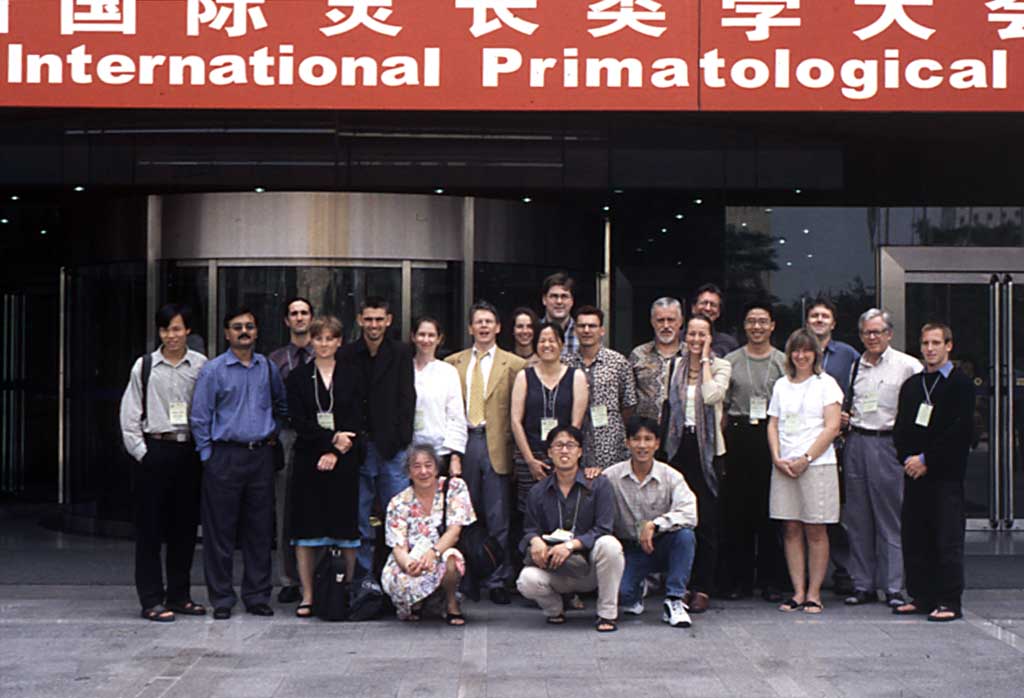Symposium on Gibbon
Diversity and Conservation:
Concluding Resolution
|
 |
Back to News
Page

Thomas Geissmann
Gibbon Research Lab., Hannover
thomas.geissmann@thiho-hannover.de
9 August 2002
As a final element of the three-day symposium on "Gibbon Diversity and Conservation",
held at the 19th Congress of the International Primatological Society (Beijing, China,
August 4-9, 2002), participants were invited to contribute to a roundtable discussion
on the topic: "Getting gibbons out of the shadow of the great apes: What should
be done? What can be done? Where are the priorities?" The roundtable discussion
was held on 9 September 2002. The participants of the roundtable discussion included,
in alphabetical order:
J.R.B. Alfred, Warren Y. Brockelman, David J. Chivers,
Susan M. Cheyne, Robert Dallmann, Jayanta Das, Ardith Eudey, Thomas Geissmann, Nguyen
Manh Ha, Joe-Won Huh, Xuelong Jiang, Heui-Soo Kim, Susan Lappan, Katja Liebal, Barney
Long, Jean Martin, Shirley McGreal, Nicholas Malone, Lori K. Sheeran, Maria Ujhelyi
The participants came to the following resolution:
Resolution
The ape closest to extinction, with less than 50 individuals, is a black crested
gibbon hanging on in tiny forest fragments in Vietnam and China. This exemplifies
the crisis facing the most diverse and endangered of the apes. The unique songs of
these spectacular acrobats are fast fading from Asia's disappearing forests. Considering
that the gibbons include the most critically endangered primates in the world, we,
the gibbon specialists within the International Primatological Society at its 19th
congress at Beijing, China, resolve that:
- top priority be given to preventing the first ape
extinctions of the 21st century;
- immediate action be taken to protect remaining
gibbon populations and their habitats.
Of the 12 gibbon species comprising at least 29 taxa we have identified the following
as the 10 most endangered:
- Cao-vit black crested gibbon (Nomascus sp.
cf. nasutus nasutus)
- Hainan black crested gibbon (Nomascus sp.
cf. nasutus hainanus)
- Northern white-cheeked gibbon (Nomascus leucogenys
leucogenys)
- Western black crested gibbon (Nomascus concolor)
- Silvery gibbon (Hylobates moloch)
- Kloss's gibbon (Hylobates klossii)
- Southern white-cheeked gibbon (Nomascus leucogenys
siki)
- Yellow-cheeked gibbon (Nomascus gabriellae)
- Pileated gibbon (Hylobates pileatus)
- Western hoolock (Bunopithecus hoolock hoolock)
We recommend the following priority actions:
- Promote gibbons as flagship species at local, national
and international levels.
- Conduct a conservation status review, including
population census and monitoring.
- Create community support for conservation at local
level.
- Provide training and support for protected area
management and law enforcement.
- Create private public partnerships for developing
sustainable funding initiatives.
- Increase support for research on conservation biology,
systematics, demography and behavioural ecology.
Top 4 threats
- Habitat loss and fragmentation
- Habitat degradation
- Hunting (food, medicine, sport)
- Illegal trade (pets, medicine)
Underlying causes
- Poor management of protected areas
- Poor enforcement of wildlife laws
- Lack of awareness at local, national and international
levels
- Rural poverty
|


Participants of the symposium on "Gibbon Diversity and Conservation", 8
September 2002

Site by Thomas Geissmann.
For comments & suggestions, please email to
webmaster@gibbons.de
|
Gibbon
Research Lab.
Home:
|

|
Gibbon
Network
Home:
|

|
![]()
